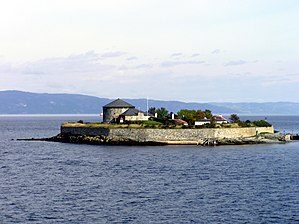Munkholmen
| Munkholmen | ||
|---|---|---|
| Munkholmen Island | ||
| Waters | Trondheimsfjord ( Northern European Sea ) | |
| Geographical location | 63 ° 27 '4 " N , 10 ° 23' 1" E | |
|
|
||
| length | 480 m | |
| width | 200 m | |
| surface | 13 ha | |
| Munkholmen - a popular destination | ||
Munkholmen is a small island in the Trondheimsfjord about two kilometers outside the city of Trondheim . In summer it is a popular destination for swimming and sun loungers. Therefore there is a regular boat connection from Trondheim ( Ravnkloa ). Munkholmen is also rich in history and is a listed building.
history
Snorri Sturluson mentions Munkholmen as " Nidarholm " - a place of execution at the time. Up until the Reformation there was a monastery on the island. In the 17th century the fortress "Munckholm" was built, which also served as a state prison, and the name "Munkholmen" was established. German troops built the island into a permanent air defense position during the occupation of Norway in World War II .
Execution site before the 12th century
Before the 12th century, the island was considered a place of execution . It is said that in 995 Olav Tryggvason had Håkon Sigurdsson's head displayed on a pole there.
Monastery 1100–1537
According to Icelandic sources, the Benedictine monastery “Nidarholm” was founded around the year 1100 and was dedicated to Saint Benedict and Saint Lawrence. Other sources claim that the monastery was built by Canute the Great in 1028 . In 1135, King Harald Gille locked up his defeated nephew and rival Magnus here after blinding and mutilating him.
The monastery became more and more powerful over time, owned large estates on the mainland, operated a mill in Ila (now a district of Trondheim), its own shipping company and trade with England. The monastery burned three times: in 1210, 1317 and 1531 - shortly before the Reformation in Norway in 1537. It was the last Catholic bastion in Norway, but the men of the Archbishop of Trondheim, Olav Engelbrektsson , had to surrender in the end.
After the Reformation, the monastery fell into disrepair. The island was used as pasture for the royal court in Trondheim until it was fortified in the 17th century. In the course of this construction work, the last remains of the monastery disappeared and the island was named "Munkholmen".
Fortress 1660-1825
In the two Karl Gustav Wars between 1657 and 1660, Trondheim was occupied by the Swedes, who fortified the island with a makeshift cannon battery. In 1660, Denmark-Norway recaptured Trøndelag from the Swedes and began work on a permanent fortification on the island.
- 1660-1661 : A simple defensive wall and the first commandant's apartment are built from wood and equipped with 18 cannons.
- 1671-1674 : The construction of the large central tower begins. The inner tower is being completed.
- 1680-1690 : The old outer walls are razed and replaced with solid masonry. Protruding bastions, which will later form a star-shaped fortress, will be built, as will a new commandant's apartment. The fortress gets 35 cannons. Since Munkholmen is also to be used as a state prison, common rooms are also set up in the tower.
- 1690-1707 : On August 26th, 1690 the Munckholm fortress is inaugurated. In 1695 the commandant's apartment got its current appearance. In the next few years the outer walls with the pointed bastions will be completed to form a “star fortress”. The fortress now covers most of the island.
State prison 1680–1850
Munkholmen was also used as a state prison from 1680 to 1850. The best known among those imprisoned mostly for political reasons was the Danish statesman Peder Schumacher Griffenfeld (1635–1699), who spent the years 1680–1698 here.
Sea fortress 1825–1893
The Napoleonic Wars showed that because of the introduction of new war strategies and techniques, the star-shaped fortresses were not effective enough. New fortifications were given a polygonal shape. Accordingly, the Munkholmen sea fortress was rebuilt to the shape it still has today. After its completion in 1850, it had walls around 8-10 meters thick, 60 cannons and space for up to 500 men. A vault was built in the central tower as an ammunition store and the prison cells were removed.
Munkholmen was one of the strongest fortresses in Scandinavia in its time, but did not experience any fighting until it was abandoned in 1893.
German defense system in World War II
During the German occupation of Norway in World War II (1940–1945), the island was used as a defensive fortification "Battery Munkholmen" to protect u. a. used the submarine bases " Dora " near Trondheim. German troops rebuilt parts of the fortress and set up a surveillance system and six flak positions . The plant's concrete foundations can still be seen there today.
Known prisoners on Munkholmen
- Magnus the Blind (1135–1137)
- Peder Schumacher Griffenfeld (1680–1698)
Excursion destination
Munkholmen is a popular destination for both Trondheimers and tourists. Today a passenger boat goes every hour between Ravnkloa (harbor) and Munkholmen during the summer months. Inside the fortress there are beautiful lawns for sunbathing and picnicking, as well as a restaurant. Outside the walls is one of Trondheim's most popular bathing beaches.
museum
In the fortress there are guided tours in different languages several times a day in summer.
Web links
- Munkholmen in the store norske leksikon (Norwegian)
- Friends of Munkholmens (Norwegian)





